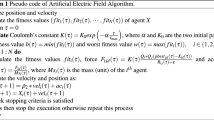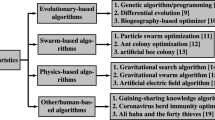Abstract
Artificial electric field algorithm (AEFA) is a potential global optimization algorithm proposed in recent years and has been successfully applied to various engineering optimizations. However, precocious convergence tends to occur when solving complex engineering optimization problems. To avoid premature convergence to some extent, an artificial electric field algorithm with inertia and repulsion (IRAEFA) is proposed. The IRAEFA algorithm introduces the inertia mechanism and the repulsion between charges, expands the search space, increases the diversity of population, balances the exploration and development ability of the algorithm, and avoids the algorithm falling into the local optimal solution. Finally, the IRAEFA algorithm is used to solve the spherical mining spanning tree (MST) problem, and the results obtained are compared and analyzed with the results of other well-known metaheuristics optimization algorithms. Experimental results show that the proposed algorithm has better performance than other algorithms in solving spherical MST problems.













































Similar content being viewed by others
References
Reinhard D (2000) Graph Theory. Mathematical Gazette 173:67–128
Chou H, Premkumar G, C., Chu H (2001) Genetic algorithms for communications network design-an empirical study of the factors that influence performance. IEEE Trans Evolution Comput 5:236–249
Beardwood J, Halton JJH, Hammersley JM (1959) The shortest path through many points. Mathematical Proc Cambridge Philos Soc 55:299–327
Vitaly O, Singler PSJ (2009) The filter-kruskal minimum spanning tree algorithm. Proceedings of the Workshop on Algorithm Engineering and Experiments, ALENEX 2009, New York, New York, USA, January 3, 2009. Soc Indust Appl Mathematics
Bo Jiang Z (2009) Li. Research on minimum spanning tree based on prim algorithm. Comput Eng Design 30(13):3244–3247
Beheshti Zahra SMH (2013) Shamsuddin. A review of population-based meta-heuristic algorithm. Int J Advances Soft Comput Applic 5:1–35
Back T (1996) Evolutionary Algorithms in Theory and Practice: Evolution Strategies, Evolutionary Programming, Genetic Algorithms, Oxford University press
Webster B, Bernhard PJ (2003) A Local Search Optimization Algorithm Based on Natural Principles of Gravitation. Proceedings of the International Conference on Information and Knowledge Engineering. IKE'03, June 23 - 26, 2003, Las Vegas, Nevada, USA, Vol. 1. DBLP
G Beni, J Wang (1993) Swarm Intelligence in Cellular Robotic Systems. Robots and Biological Systems: Towards a New Bionics. Springer, pp. 703-712.
Holland John H (1992) Genetic Algorithms. Sci Am
Storn R (2008) Differential Evolution Research – Trends and Open Questions. Stud Comput Intell 143:1–31
Simon D (2008) Biogeography-Based Optimization. IEEE Trans Evolution Comput 12:702–713
Rechenberg, I (1994) Evolutionary Strategy. Computational Intelligence Imitating Life
Fogel GB (2011) Evolutionary Programming. In: Rozenberg G, Bäck T, Kok JN (eds) Handbook of Natural Computing. Springer, Berlin
Erol OK, Eksin I (2006) A new optimization method: big bang–big crunch. Adv Eng Softw 37:106–111
Rashedi E, Nezamabadi-Pour H, Saryazdi S (2009) GSA: a gravitational search algorithm. Inform Sci 179:2232–2248
Kaveh A, Talatahari S (2010) A novel heuristic optimization method: charged system search. Acta Mech 213:267–289
Tayarani-N MH. Akbarzadeh-T MR (2008) Magnetic Optimization Algorithms a new synthesis. 2008 IEEE Congress on Evolutionary Computation, IEEE
Formato RA (2007) Central force optimization. Prog Electromagn Res 77:425–491
Alatas B (2011) ACROA: artificial chemical reaction optimization algorithm for global optimization. Expert Syst Appl 38:13170–13180
Hatamlou A (2013) Black hole: A new heuristic optimization approach for data clustering. Inform Sci 222:175–184
Du H, Wu X, Zhuang J (2006) Small-World Optimization Algorithm for Function Optimization. International Conference on Natural Computation, Springer, pp. 264-273
Shah-Hosseini H (2011) Principal components analysis by the galaxy-based search algorithm: a novel metaheuristic for continuous optimisation. Int J Comput Sci Eng 6:132–140
Hsiao YT, et al (2006) A novel optimization algorithm: space gravitational optimization." IEEE International Conference on Systems IEEE
Kennedy J, Eberhart R (1995) Particle swarm optimization, in: Proceedings of ICNN’95 - International Conference on Neural Networks vol 4, pp 1942-1948
Karaboga D, Basturk B (2007) A powerful and efficient algorithm for numerical function optimization: artificial bee colony (abc) algorithm. J Glob Optim 39:459–471
Dorigo M, Maniezzo V, Colorni A (1996) Ant system: optimization by a colony of cooperating agents. IEEE Trans Syst Man Cybern B 26:29–41
Yang XS (2009) Firefly Algorithms for Multimodal Optimization. International Symposium on Stochastic Algorithms, Springer, pp 169-178
Yang XS, Gandomi AH (2012) Bat algorithm: a novel approach for global engineering optimization. Eng Comput 29(5):464–483
Valian E, Valian E (2013) A cuckoo search algorithm by Lévy flights for solving reliability redundancy allocation problems. Eng Optimiz 45:1273–1286
Uymaz SA, Tezel G, Yel E (2015) Artificial algae algorithm (AAA) for nonlinear global optimization. Appl Soft Comput 31:153–171
Kiran MS (2015) TSA: Tree-seed algorithm for continuous optimization. Expert Syst Appl 42:6686–6698
Mirjalili S, Mirjalili SM, Lewis A (2014) Grey Wolf Optimizer. Advance Eng Software 69:46–61
James J, Li VO (2015) A social spider algorithm for global optimization. Appl Soft Comput 30:614–627
Mirjalili S (2015) Moth-flame optimization algorithm: A novel nature-inspired heuristic paradigm. Knowl-Based Syst 89:228–249
Mirjalili S, Lewis A (2016) The whale optimization algorithm. Adv Eng Softw 95:51–67
Kaveh A, Farhoudi N (2013) A new optimization method: dolphin echolocation. Adv Eng Softw 59:53–70
Chu S-C, Tsai P-W, Pan J-S (2006) Cat swarm optimization, in: Pacific Rim International Conference on Artificial Intelligence, Springer, pp. 854-858
Yazdani M, Jolai F (2016) Lion optimization algorithm (LOA): a nature-inspired metaheuristic algorithm. J Comput Des Eng 3:24–36
Bo X, Gao WJ (2014) Fruit Fly Optimization Algorithm. In: Innovative Computational Intelligence: A Rough Guide to 134 Clever Algorithms. Intelligent Systems Reference Library, vol 62. Springer, Cham
Khishe M., M. R. Mosavi. Chimp optimization algorithm. Expert Syst Appl , 2020, 149:113338.
Yadav AA (2019) AEFA: Artificial electric field algorithm for global optimization. Swarm Evolution Comput 48:93–108
Yadav AA, Kumar N (2020) Artificial Electric Field Algorithm for Engineering Optimization Problems. Expert Systems with Applications:113308
Yadav AA (2020) Discrete artificial electric field algorithm for high-order graph matching. Appl Soft Comput 92:106260
Hemant P, Rani R (2020) An Improved Artificial Electric Field Algorithm for Multi-Objective Optimization. Processes 8:584
Demirören A, Ekinci S, Hekimoğlu B, Izci D (2020) Opposition-based artificial electric field algorithm and its application to FOPID controller design for unstable magnetic ball suspension system. Eng Sci Technol: Int J
Janjanam L, Saha SK, Kar R, Mandal D (2020) Volterra filter modelling of non-linear system using Artificial Electric Field algorithm assisted Kalman filter and its experimental evaluation. ISA Transactions
Ur A et al (2009) Genetic Algorithm Based Solution For TSP On A Sphere. Mathematic Comput Appl 14:219–228
Eldem H, Ülker E (2017) The application of ant colony optimization in the solution of 3D traveling salesman problem on a sphere. Eng Sci Technol Int J 20:1242–1248
Chen X, Zhou Y, Tang Z, Luo Q (2017) A Hybrid Algorithm Combining Glowworm Swarm Optimization and Complete 2-opt Algorithm for Spherical Travelling Salesman Problems. Appl Soft Comput 58:104–114
Zhou Y, Wang R, Zhao C et al (2019) Discrete greedy flower pollination algorithm for spherical traveling salesman problem. Neural Comput Applic 31:2155–2170
Ouyang X, Zhou Y, Luo Q, Chen H (2013) A Novel Discrete Cuckoo Search Algorithm for Spherical Traveling Salesman Problem. Appl Mathematics Inform Sci 2:777–784
Crabb MC (2006) Research note: Counting nilpotent endomorphisms. Finite Fields Appl 12:151–154
Atashpaz-Gargari E, Lucas C (2008) Imperialist competitive algorithm: An algorithm for optimization inspired by imperialistic competition. IEEE Congress on Evolutionary Computation IEEE
Tan Y, Zhu Y (2010) Fireworks Algorithm for Optimization. Advances in Swarm Intelligence. First International Conference, ICSI 2010, Beijing June 12-15, Proceedings, Part I 2010
Dhiman G, Kumar V (2019) Seagull optimization algorithm: Theory and its applications for large-scale industrial engineering problems. Knowledge Based Sys 165:169–196
Shahrzad S, Seyedali M, Rew L (2017) Grasshopper Optimisation Algorithm: Theory and application. Advance Eng Software 105:30–47
Li S, Chen H, Wang M, Heidari AA, Mirjalili S (2020) Slime mould algorithm: A new method for stochastic optimization. Future Gen Comput Syst 111:300–323
Abualigah L, Diabat A, Mirjalili S, Elaziz MA, Gandomi AH (2021) The Arithmetic Optimization Algorithm. Comput Methods Appl Mech Engrg 376:113609
Wu D, Xu J, Gao X-Z, Zhao H (2020) An enhanced MSIQDE algorithm with novel multiple strategies for global optimization problems. IEEE Trans Syst Man Cybernet: Syst. https://doi.org/10.1109/TSMC.2020.3030792
Acknowledgements
This work is supported by National Science Foundation of China under Grant Nos. 62066005, 61563008, and by Project of Guangxi Natural Science Foundation under Grant No. 2018GXNSFAA138146.Basic Ability Improvement Project for Young and Middle-aged Teachers in Co-lleges and Universities in Guangxi under Grant No. 2020KY04029.
Author information
Authors and Affiliations
Corresponding author
Ethics declarations
Conflict of interest
The authors declare that they have no conflicts of interest.
Additional information
Publisher’s note
Springer Nature remains neutral with regard to jurisdictional claims in published maps and institutional affiliations.nications network design
Rights and permissions
About this article
Cite this article
Bi, J., Zhou, Y., Tang, Z. et al. Artificial electric field algorithm with inertia and repulsion for spherical minimum spanning tree. Appl Intell 52, 195–214 (2022). https://doi.org/10.1007/s10489-021-02415-1
Accepted:
Published:
Issue Date:
DOI: https://doi.org/10.1007/s10489-021-02415-1




